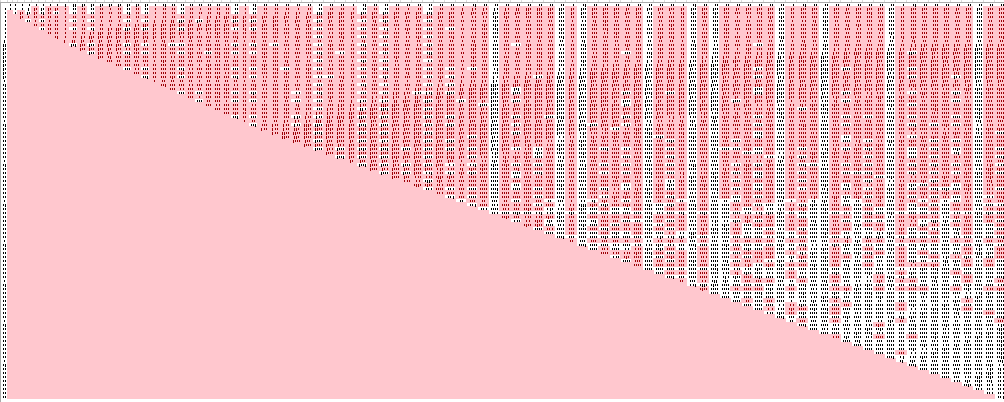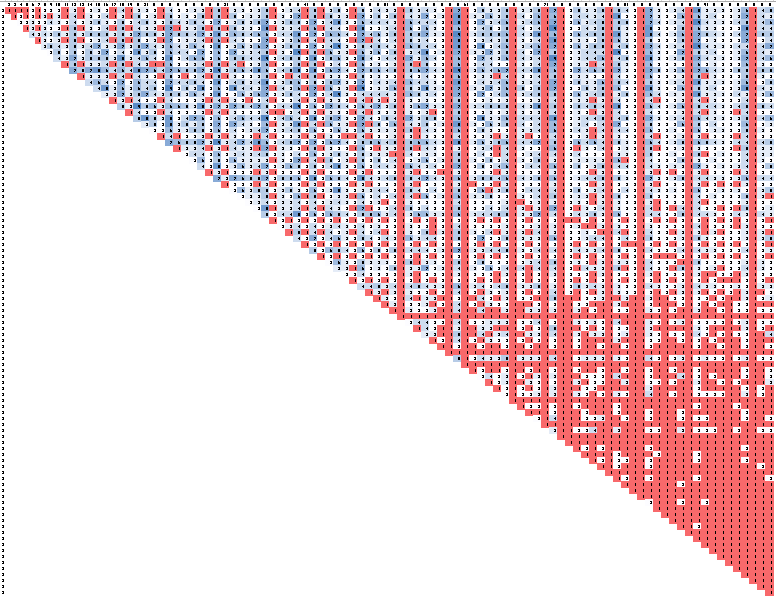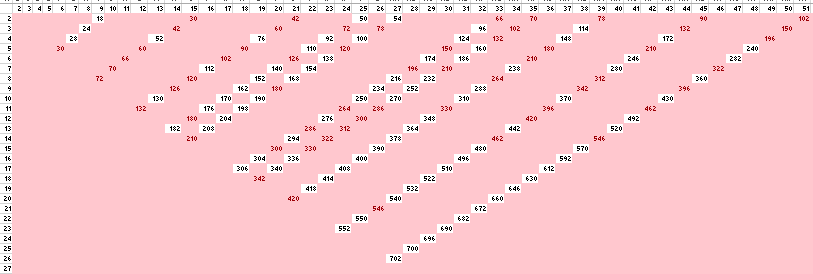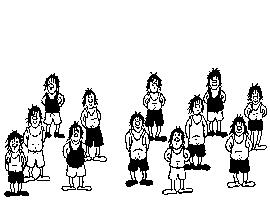Not the answer, but might reveal more information that people want to know:
[tab]I got it with heavy reliance upon Excel tables, formulas, and conditional formatting to simplify the brute force parts. The brute force seems to be inescapable, as the problem statement at the Post suggests.[/tab]
The answer and how I got there:
[tab]Peter’s statement that he doesn’t know doesn’t tell us much. There are actually a lot of numbers that are ruled out immediately:
This is a table of all the possible products (zoomed way out, the big picture is what’s important here). Along the top and left are numbers 2-99, and the product of any two numbers is at the intersection of the respective row/column(2x2 is in the upper left, 99x99 is in the lower right). For simplicity, I only filled in the upper half of the table, since the lower half is identical. Cells highlighted in red appear more than once; those in white are unique. From Peter’s statement, we know that it’s none of the unique values (otherwise he would know immediately), but that doesn’t get us very far.
Sarah’s statement, “I knew you didn’t know” tells us that whatever sum she has, every product of every pair of integers that sums to that is non-unique. If there were two numbers that added to the number she knows, and multiplied to a unique product, then she wouldn’t know whether or not Peter knew.
This table shows the number of times each product appears in the entire set. Red cells appear once, white cells twice, and the bluer the more the appear from there. This chart wasn’t necessary, it was the result of what turned out to be a dead end, but it makes it a little easier to see some patterns and it’s just s’damn pretty, I didn’t want it to go to waste.
For any sum, there will be a diagonal line sloping up and right that has the same sum (because, e.g., 6+5 = 7+4 = 8+3 = 9+2 = 11). So in this chart, I was looking for the sloping lines that don’t contain unique values, i.e. that had no reds. This immediately eliminates everthing to the right of the solid red column around the middle of the chart (53xY): every diagonal line that extends beyond that column will have at least 1 unique product, and we need diagonal lines that have no unique products. There are relatively few lines, and we can take the list of sums corresponding to those lines: 11,17,23,27,35,37,41,47,53. We know the sum is one of those numbers.
Peter’s next answer tells us that, among the pairs that sum to 11,17,23,27,35,37,41,47, or 53, his number must be unique: if it appeared in two of the diagonally sloping lines, he wouldn’t know from Sarah’s statement which line it was in, i.e. what the sum of the numbers is. So I made this chart:
This shows only the products that correspond to the available sums, and it’s highlighted to show duplicates (pink if a number appears more than once, white if not). Peter’s number is one of the numbers in white.
Finally, we look at Sarah’s last statement. Peter knows because his product is one of the values in white on the previous chart, that is, there is only one combination of numbers that falls along the diagonally sloping lines that has a product equal to the one he knows. This is enough to tell Sarah what number it is only if it is the only value in white with the sum she knows. And if we look along the diagonal lines, we see that 52, at the intersection of 4 and 13, is the only white number in its line (the line of numbers that sum to 17), and that no other line has such a number.
And so, because Sarah knows the answer, we know the answer. QED[/tab]




